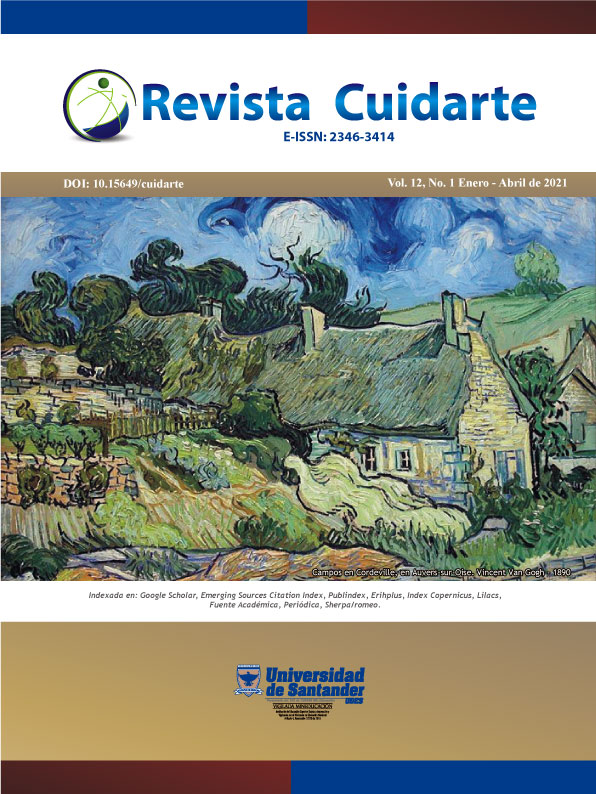Uso do desenho-estória para apreensão de entendimentos e sentimentos de crianças institucionalizadas sobre agressão física
DOI:
https://doi.org/10.15649/cuidarte.1204Palabras clave:
Maus-Tratos Infantis, Punição, Criança Abandonada, Criança Acolhida, Defesa da Criança e do AdolescenteResumen
Introdução: A punição corporal de crianças é uma prática recorrente que prejudica o seu desenvolvimento físico e emocional. Objetivo: apreender entendimentos e sentimentos de um grupo de crianças sobre a agressão física praticada por pais ou responsáveis. Materiais e Métodos: estudo descritivo, de abordagem qualitativa e uso do desenho-estória para responder ao estímulo indutor: o que vem à sua cabeça quando você ouve falar: “bater em criança”? Resultados: emergiram sentimentos de amor e ódio, culpa, tristeza, ressentimentos, desejo de vingança, vergonha e o entendimento de agressão física como uma atitude negativa e prejudicial. Conclusão: as crianças demonstraram ansiedade, timidez, agressividade, introspecção e tendência ao isolamento social. Para elas, as punições físicas constituíram episódios negativos que poderiam levá-las à morte, sugerindo que fossem substituídas por diálogo ou castigo.
Como citar este artigo: Lima, Juciara Karla de Souza; Lira, Margaret Olinda de Souza Carvalho e; Oliveira, Jeany Freire de; Campos, Fernando Vitor Alves; Paiva, Levi Olinda Lira de. Uso do desenho-estória para apreensão de entendimentos e sentimentos de crianças institucionalizadas sobre agressão física. Revista Cuidarte. 2021;12(1):e1204. http://dx.doi.org/10.15649/cuidarte.1204
.
Referencias
OPAS. INSPIRE. Sete estratégias para pôr fim à violência contra crianças. Washington, D.C.: OPAS, 2017.
Constantino P, Assis SG, Mesquita VSF. Crianças, Adolescentes e famílias em SAI. In: Assis SG, Farias LOP, editors. Levantamento Nacional das Crianças e Adolescentes em Serviço de Acolhimento. São Paulo: Hucitec; 2013. p. 160-220.
Unicef. Know Violence in Childhood. Ending Violence in Childhood. Global Report, 2017.
Brasil. Ministério dos Direitos Humanos. Ouvidoria Nacional dos Direitos Humanos. Balanço Ouvidoria. Brasil, 2018.
Moura JP, Almeira JLS, Araújo JP, Menezes RMP, Chaves AEP. Implicações da violência na infância e adolescência. Ver. Univ. Vale Rio Verde. 2014;12(1):513-524. http://dx.doi.org/10.5892/ruvrd.v12i1.1415
Nunes AJ, Sales MCV. Violência contra crianças no cenário brasileiro. Ciênc. Saúde Colet. 2016; 21(3):871-880. http://dx.doi.org/10.1590/1413-81232015213.08182014
Correia CC. O desenho na avaliação pedagógica e psicopedagógica. Ciência Atual. 2016;8(2):05-17.
Santini PM, Williams LCA. Parenting Programs to Prevent Corporal Punishment: A Systematic Review. Paidéia (Ribeirão Preto). 2016;26(63):121-129. http://dx.doi.org/10.1590/1982-43272663201614
Gershoff ET, Grogan-Kaylor A. Spanking and child outcomes: Old controversies and new meta-analyses. J. Fam. Psychol. 2016;30(4):453–469. https://doi.org/10.1037/fam0000191
Linhares ABM. Estresse precoce no desenvolvimento: impactos na saúde e mecanismos de proteção. Estud psicol (Campinas) [online]. 2016;33(4):587-599. http://dx.doi.org/10.1590/1982-02752016000400003.
Gershoff ET. Should Parents’ Physical Punishment of Children Be Considered a Source of Toxic Stress That Affects Brain Development? Fam. Relat. 2016;65:151–62. https://doi.org/10.1111/fare.12177
Bandeira AG, Gabriel JE. Impactos dos transtornos alimentares maternos sobre o desenvolvimento físico e psicossocial dos filhos: uma revisão sistemática. Rev. Ciênc. Méd. Biol. 2016;15(1):88-94. http://dx.doi.org/10.9771/cmbio.v15i1.14461
Hildebrand NA, Celeri EHRV, Morcillo AM, Zanolli ML. Violência doméstica e risco para problemas de saúde mental em crianças e adolescentes. Psicol. Reflex. Crit. 2015;28(2):213-221. http://dx.doi.org/10.1590/1678-7153.201528201
Bolze SDA, Schmidt B, Böing E, Crepaldi MA. Conflitos Conjugais e Parentais em Famílias com Crianças: Características e Estratégias de Resolução. Paidéia (Ribeirão Preto). 2017;27(supl.1):457-465. http://dx.doi.org/10.1590/1982-432727s1201711
Avanci JQ, Pinto LW, Assis SG. Atendimento dos casos de violência em serviços de urgência e emergência brasileiros com foco nas relações intrafamiliares e nos ciclos de vida. Ciênc. Saúde Colet. 2017;22(9):2825-2840. http://dx.doi.org/10.1590/1413-81232017229.13352017
Lira MOSC, Nitschke RG, Rodrigues AD, Rodrigues VP, Couto TM, Diniz NMF. Sobrevivendo ao abuso sexual no cotidiano familiar: formas de resistência utilizadas por crianças e adolescentes. Texto Contexto Enferm. 2017;26(2):01-09. http://dx.doi.org/10.1590/0104-07072017000050016
Carrillo-Urrego A. Castigos en la crianza de los hijos e hijas: un estado de la cuestión. Rev. Latinoam. Cienc. Soc. Niñez Juv. 2018;16(2):719-740. https://doi.org/10.11600/1692715x.16206
Guisso L, Bolze SDA, Viera ML. Práticas parentais positivas e programas de treinamento parental: uma revisão sistemática da literatura. Contextos Clínicos. 2019;12(1):226-55. https://doi.org/10.4013/ctc.2019.121.10
Brasil. Casa civil. Lei n.13.010, de 26 de junho de 2014. Altera a Lei no 8.069, de 13 de julho de 1990 (Estatuto da Criança e do Adolescente), para estabelecer o direito da criança e do adolescente de serem educados e cuidados sem o uso de castigos físicos ou de tratamento cruel ou degradante, e altera a Lei no 9.394, de 20 de dezembro de 1996. Brasília, DF, 2014.
Brasil. Lei Federal N. 8069, de 13 de julho de 1990. Estatuto da Criança e do Adolescente. Brasília, DF, 1990.
Souto DF, Zanin L, Ambrosano GMB, Flório FM. Violência contra crianças e adolescentes: perfil e tendências decorrentes da Lei nº 13.010. Rev. Bras. Enferm. 2018;71(supl.3):1237-1246. http://dx.doi.org/10.1590/0034-7167-2017-0048
Leoncio ET, Souza SRP, Machado JLM. Degradação do vínculo parental e violência contra a criança: o uso do genograma familiar na prática clínica pediátrica. Rev. Paul. Pediatr. 2017;35(2):185-190. http://dx.doi.org/10.1590/1984-0462/;2017;35;2;00009
Descargas
Publicado
Cómo citar
Descargas
Número
Sección
Categorías
Licencia
Journal Cuidarte, scientific publication of open access, is licensed under a Creative Commons Attribution (CC BY-NC), which permits use, distribution and reproduction in any medium, provided the original work is properly cited and is not used for commercial purposes.
Any other form of use such as reproduction, transformation, public communication or distribution, for profit, requires the prior authorization of the University of Santander UDES.
The names and e-mail addresses entered in the Journal Cuidarte will be used exclusively for the purposes stated by this magazine and will not be available for any other purpose or other person.
The articles published in the Journal Cuidarte represent the criteria of their authors and do not necessarily constitute the official opinion of the University of Santander UDES.




